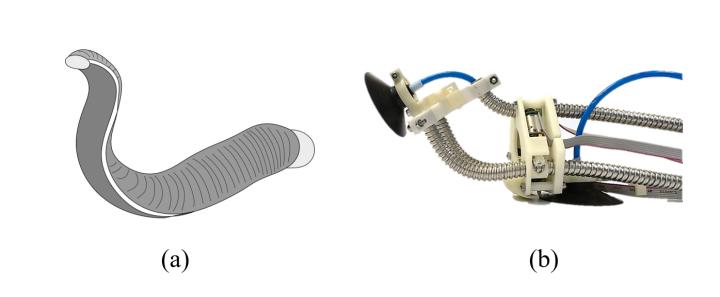The natural world continues to inspire designers of robots. The menagerie of creatures on which robots have been based, which already includes geckos, cephalopods and dogs, now includes the squirming, bloodsucking worms of many people’s nightmares: the leech.
While leeches have mainly been notable for their history in medicine and as inspiration for anticoagulant drugs, researchers at Toyohashi University of Technology in Japan and the University of Cambridge have collaborated on exploiting their physical abilities, rather than their feeding behaviour.

Leeches have a peculiar and characteristic method of locomotion, with suction cups at either end of their soft bodies. Holding on firmly to a surface with the suction cup at their rear, they reach forward as far as they can with their heads and attach that cup, then detach the rear and arch forward to bring the rear close to the front, forming their body into a loop, then detach the front and reach forward again. Land-living leeches can move around their mountain or forest environments with few constraints, clinging to a wide variety of surfaces and unconcerned with the orientation or gradient of the surface on which they move.
Research leaders Tomoaki Mashimo of Toyohashi and Fumiya Iida of Cambridge designed the locomotion system of their robot using a tube structure of shower hose, consisting of a flexible tube surrounded by a flexible plate with an S-shaped spirally wound profile which makes it lightweight, flexible and extensible. The robot has a body composed of three flexible tubes connected in parallel by a mechanism containing three gear wheels, each of which engages with the helical groove on one hose. The front end and joining component support suction cups, allowing the robot to attach and detach from surfaces.
Advancing one gear relative to the other two feeds a length of tube through the joining component, which deforms the entire assembly to bend away from the advancing hose. Manipulating the three gears can make the robot arch its body in any direction, like the leech. Obviously, the robot is called LEeCH (longitudinally extensible continuum-robot inspired by Hirudinea)
"I came up with the idea in the bathroom of my house,” explained Ayato Kanada, lead author of a paper on the research published in the journal Soft Robotics. “The shower hose went wild as if it had a life when I inadvertently turned on the faucet at maximum. Then an idea occurred to me that if I could manipulate a hose, I might be able to make a robot with dynamic movement of a living creature."
In tests, the robot showed itself to be capable of free movement on a vertical wall. In a first for soft robotics, it managed to climb to the top of the wall and then transition to its opposite side by bending over the top. Such movement could be extremely useful in applications such as building inspection and maintenance, and assisting with search and rescue at disaster and conflict sites. Because of the light weight and resilience of the structure, it may also be useful to work as a cobot in proximity to humans, possibly replacing one of its end suckers with a manipulator. The team is now considering the effect of filling the hollow tubes with fluids to manipulate their stiffness.










Breaking the 15MW Barrier with Next-Gen Wind Turbines
Hi Martin, a wind turbine blade functions very much like an airplane wing in a climb. Obviously in one case the air is moving and the other the air is...